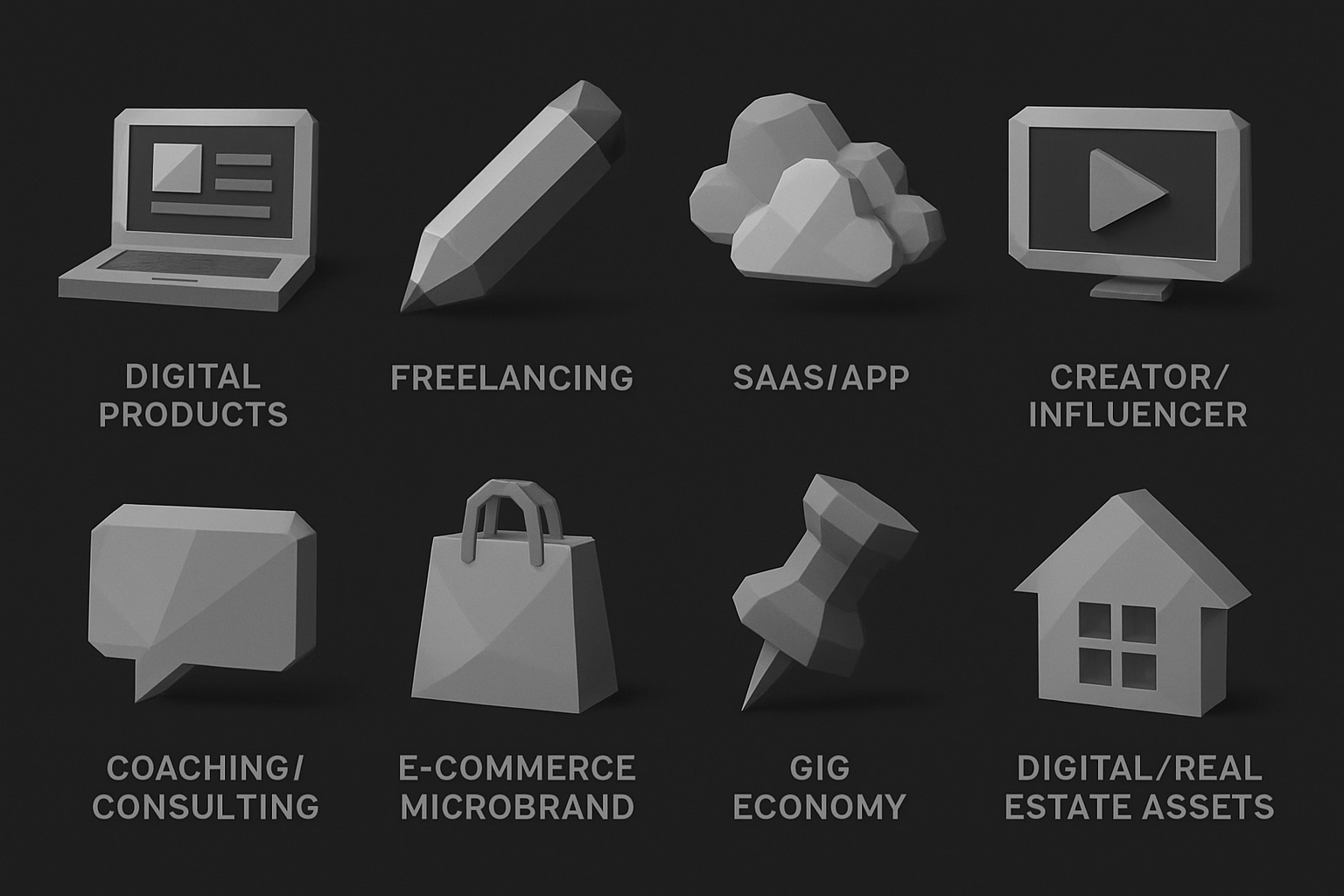Are you feeling the urge to break free from the nine-to-five grind? You’re not alone. As 2025 approaches, more people are seeking ways to work for yourself, craving independence and true flexibility.
This guide is designed to help you take control of your career. We’ll explore eight smart, actionable ways—ranging from digital entrepreneurship and freelancing to tapping into the gig economy.
Ready to unlock new opportunities and discover the benefits of working for yourself? Read on for practical strategies to shape your future.
Why 2025 Is the Best Time to Work for Yourself
The landscape for anyone who wants to work for yourself has never been more promising than it will be in 2025. The world is experiencing a seismic shift—remote work is now the norm, not the exception. Digital tools, platforms, and AI-powered assistants are lowering the barriers for launching a business or side-hustle from your own living room.

Key Trends Shaping 2025
Remote work isn't just a pandemic-era trend—it's become woven into the fabric of modern business. Companies are embracing distributed teams, and technologies like AI and automation are empowering individuals to work for yourself with unprecedented efficiency. No-code and low-code platforms mean you don’t need to be a developer to build apps or launch services.
AI tools now automate everything from bookkeeping to marketing, making entrepreneurship less daunting. The rise of digital platforms lets you reach global audiences, test ideas quickly, and scale faster than ever.
Economic Shifts and Compelling Data
The gig economy and the creator economy are booming. Companies are hiring more freelancers and independent contractors, leading to a surge in demand for specialized skills. According to recent data, nearly 40% of small businesses are profitable, and self-employment is on the rise.
| Statistic | 2025 Data |
|---|---|
| U.S. workforce in gig/freelance roles | 36% |
| Small business profitability rate | 40% |
| Increase in creator economy earnings | +22% YoY |
Many are leaving traditional 9-to-5 jobs for flexibility, autonomy, and higher earning potential. If you plan to work for yourself, the numbers are in your favor.
Societal Changes & Success Stories
People crave work-life balance and meaningful work now more than ever. The desire to work for yourself often comes from wanting flexibility, purpose, and control over your life. Stories abound of individuals who pivoted from corporate careers to thriving solo ventures, finding fulfillment in the process.
Platforms like Substack, Shopify, and Patreon have enabled creators and entrepreneurs to monetize their expertise. As Digital Entrepreneurship Trends 2025 highlights, the rise of no-code tools and the growing creator economy are making self-employment more accessible each year.
Opportunities, Reduced Risks, and New Challenges
In 2025, the opportunity to work for yourself comes with lower risk. You can start lean, test ideas online, and leverage automation to reduce costs. But new challenges exist: competition is fierce, and self-motivation is essential. Financial planning and adaptability are key to long-term success.
Yet, for those ready to seize the moment, 2025 offers a unique window. The blend of digital transformation, societal shifts, and economic trends means there’s never been a better time to work for yourself.
8 Smart Ways To Work For Yourself In 2025
Are you ready to work for yourself and embrace the freedom, flexibility, and control that self-employment offers? In 2025, technology, remote work, and new business models are transforming how people take charge of their careers. Whether you want to build a digital empire or simply earn a living on your own terms, there’s never been a better time to explore these smart, actionable paths.

1. Launch a Digital Product Business
Launching a digital product business is one of the most scalable ways to work for yourself in 2025. Imagine turning your expertise into e-books, online courses, digital templates, or innovative tools—products that can be sold repeatedly with minimal overhead.
Platforms like Gumroad, Teachable, and Shopify have made it easier than ever to distribute products globally. Automation tools handle payments, delivery, and customer management, freeing up your time. This creates real potential for passive income while you focus on growing your audience or developing new offers.
Consider creators who’ve packaged their knowledge into courses or templates, earning five- or six-figure incomes while helping others. According to market research, the global e-learning market alone is projected to surpass $400 billion by 2026, with AI-powered products and niche digital solutions seeing explosive growth.
Key skills you’ll need to work for yourself in this space include content creation, digital marketing, and audience engagement. The biggest advantages? Low startup costs, the ability to reach customers worldwide, and nearly limitless scalability. However, you’ll need to invest significant effort upfront and consistently promote your offerings to stand out in a crowded market.
For a step-by-step roadmap, check out the Building Digital Products Guide—it’s packed with actionable insights to help you succeed.
2. Freelance Your Professional Skills
Freelancing lets you work for yourself by offering your expertise in writing, design, programming, marketing, or consulting to clients across the globe. Platforms such as Upwork, Fiverr, and Toptal connect skilled professionals with businesses seeking talent—no matter where you live.
When you freelance, you choose your clients, set your own rates, and decide which projects excite you. This flexibility is a major draw for those looking to escape the 9-to-5. Still, it comes with challenges: finding clients, managing variable income, and marketing yourself effectively.
Freelancing is booming. According to recent Freelance Workforce Statistics 2025, over 1.1 billion people globally now freelance, with average earnings rising as demand for specialized skills grows. Top niches include web development, copywriting, and graphic design.
Success as a freelancer hinges on building an impressive portfolio, clear client communication, and often, niche specialization. Many have made the leap from traditional employment to full-time freelancing, enjoying the autonomy and control that come when you work for yourself.
Pros? You control your workload and schedule. Cons? No employer benefits and income can fluctuate.
3. Build a One-Person SaaS or App
Building a one-person SaaS (Software as a Service) or app is a powerful way to work for yourself and generate recurring revenue. With the rise of no-code and low-code tools like Bubble and Glide, you don’t need to be a coding wizard to launch a software solution that solves a real problem.
The model is simple: create a tool or app, validate it with a minimum viable product (MVP), gather user feedback, and iterate quickly. Subscription-based pricing means income is predictable and can scale as your user base grows.
Solo founders have successfully built profitable SaaS products—think of tools for project management, invoicing, or even niche-specific solutions for industries like real estate or fitness. The global SaaS market is expected to reach $700 billion by 2030, making this an exciting frontier for those who want to work for yourself and build a business with high growth potential.
Key skills include problem-solving, product development, and customer support. Pros: scalability, automation, and relatively low overhead. Cons: technical barriers (even with no-code, there’s a learning curve), and the need for ongoing updates and support.
If you’re ready to work for yourself in tech, focus on a clear pain point, validate your idea, and start small—you might be surprised how far you can go solo.
4. Become a Creator or Influencer
If you love creating content and engaging with communities, becoming a creator or influencer is a dynamic way to work for yourself. Platforms like YouTube, TikTok, Instagram, and Substack enable you to monetize your voice, skills, or passions through sponsorships, ad revenue, merchandise, and memberships.
The creator economy has exploded—data shows that over 200 million people now identify as creators, with micro-influencers (those with 10,000–100,000 followers) earning substantial incomes by serving niche audiences. Top earning niches include personal finance, education, wellness, and tech.
Consistent content creation, understanding platform algorithms, and building a loyal audience are key to success. For many, the ability to work for yourself means creative freedom, multiple income streams, and the satisfaction of turning a passion into a thriving business.
However, it’s not all glamour. There’s a risk of burnout, and your income depends on platforms you don’t control. Smart creators diversify their revenue sources and focus on authentic engagement to build resilience.
Ready to work for yourself as a creator? Start by sharing what you love, connect with your community, and explore the endless opportunities available in 2025.
5. Offer Online Coaching or Consulting Services
If you have expertise in business, wellness, leadership, or another field, online coaching or consulting is a high-impact path to work for yourself. People are increasingly seeking personalized guidance and accountability to reach their goals, creating strong demand for skilled coaches and consultants.
Platforms like Zoom, Calendly, and CoachAccountable make scheduling and delivering sessions seamless. You can offer 1:1 coaching, group programs, or hybrid products—giving you flexibility in how you work for yourself and serve clients.
Personal branding, collecting testimonials, and focusing on a specific niche are critical for standing out. The online coaching industry has seen double-digit growth in recent years, with average session rates ranging from $100 to $500+ depending on specialty and experience.
The key benefits? Deep personal fulfillment, high impact, and the ability to set your own schedule. The main downside is the time-for-money tradeoff, unless you productize your knowledge into courses or group offerings.
To work for yourself successfully in this space, build credibility through content, nurture client relationships, and continually refine your approach based on feedback.
6. Start an E-commerce Microbrand
Launching an e-commerce microbrand allows you to work for yourself by selling unique physical or print-on-demand products online. With platforms like Shopify, Etsy, and Amazon FBA, you can reach a global audience without the need for a traditional storefront.
Trends in 2025 point toward sustainable goods, custom merchandise, and dropshipping models—making it easier to manage inventory and logistics. Automation tools handle much of the heavy lifting, from order processing to customer communication.
Solo entrepreneurs have built successful microbrands with just a laptop and a great product idea. Key skills include product sourcing, branding, and digital marketing. When you work for yourself in e-commerce, you enjoy the satisfaction of building a tangible brand and seeing your creations in the hands of customers.
Pros: ownership of a physical brand, potential for high margins, and creative control. Cons: inventory risk, competition, and the challenge of managing shipping and returns.
If you’re ready to work for yourself in retail, focus on a niche, tell a compelling brand story, and leverage automation to scale efficiently.
7. Tap Into the Remote Gig Economy
The remote gig economy offers flexible, entry-level ways to work for yourself, whether you’re looking for side income or a full-time path. Gigs range from virtual assistant roles and customer support to project-based assignments—many of which require only a laptop and internet connection.
Platforms like TaskRabbit, FlexJobs, and Remote.co connect you with clients around the world. You can stack multiple gigs to build a full-time income or cherry-pick projects that fit your schedule.
The appeal? Complete flexibility, exposure to diverse industries, and an easy entry point for those new to working for yourself. However, income can be unpredictable, and finding reliable gigs takes time and persistence.
To succeed, focus on building a strong reputation, optimizing your profiles, and networking with other gig workers. Many professionals have transitioned from traditional jobs to work for yourself full time through strategic gig stacking and skill development.
The remote gig economy is a gateway for anyone ready to work for yourself—just bring adaptability and a willingness to learn.
8. Invest in Real Estate or Digital Assets
Investing in real estate or digital assets is an increasingly popular way to work for yourself and build semi-passive income streams. Options include managing rental properties remotely, hosting on Airbnb, or buying and flipping digital real estate like websites and online stores.
Automation tools—property management software, marketplaces like Flippa and Empire Flippers—make it easier to handle day-to-day tasks and transactions. The short-term rental market and online asset flipping have both seen significant growth, with more individuals choosing to work for yourself by diversifying their income.
Key tips? Conduct thorough market research, manage risks, and start with assets that match your expertise and capital. The main benefits are recurring revenue potential and asset appreciation, but you’ll need upfront investment and must navigate market fluctuations.
Many have found freedom and financial security by choosing to work for yourself through asset ownership—whether it’s a portfolio of rental properties or a network of profitable websites.
Essential Skills and Mindsets for Self-Employment Success
To successfully work for yourself in 2025, mastering the right skills and adopting a resilient mindset are just as crucial as picking the right business model. It’s not just about what you do—it’s how you approach each challenge and opportunity along the way.

Self-Motivation & Discipline
When you work for yourself, there’s no boss looking over your shoulder. That means staying productive, managing your time, and sticking to routines is all on you.
- Create a daily or weekly schedule—and stick to it.
- Set clear, achievable goals.
- Use productivity tools (like Trello or Notion) to stay on track.
Discipline is your foundation. Without it, even the best business ideas can fizzle out before they grow.
Financial Planning & Adaptability
Handling your own finances is non-negotiable. Budgeting, saving for taxes, and managing irregular income streams are essential when you work for yourself.
- Build an emergency fund to smooth out lean months.
- Track every expense and set aside tax money regularly.
- Be ready to pivot—markets shift, and your income might, too.
Adaptability is a superpower. Embrace change, and you’ll stay ahead.
Continuous Learning & Resilience
The landscape for those who work for yourself is always evolving. Success requires a commitment to ongoing learning and the ability to bounce back after setbacks.
- Dedicate time each week to learn new skills or explore trends.
- Accept that failures are part of the journey—use them as stepping stones.
- Stay curious and open-minded.
Resilience keeps you moving forward when the going gets tough. For actionable lessons and insights, check out Lessons for Digital Entrepreneurs.
Networking, Sales & Marketing
No matter how skilled you are, working for yourself means you must sell—whether it’s your services, products, or personal brand.
- Build relationships with clients, peers, and mentors.
- Don’t shy away from self-promotion—share your wins and expertise.
- Join professional groups, attend webinars, and keep your network fresh.
Effective networking and marketing open doors you didn’t know existed.
Work-Life Balance
It’s easy to blur the lines between work and rest when you work for yourself. Protect your mental health and prevent burnout by setting boundaries.
- Define your workspace—even if it’s just a corner of your living room.
- Schedule downtime and unplug after hours.
- Listen to your body and mind—rest is fuel for productivity.
Real Stories of Growth
Many people who work for yourself face setbacks, uncertainty, and self-doubt. What sets successful entrepreneurs apart is their willingness to learn, adapt, and keep going. Whether it’s bouncing back after a failed launch or finding creative ways to attract clients, real growth often comes from overcoming tough moments.
Here’s a quick summary of the essential skills and their benefits:
| Skill/Mindset | Why It Matters |
|---|---|
| Self-Motivation | Drives productivity and consistency |
| Financial Planning | Ensures stability and growth |
| Continuous Learning | Keeps you competitive |
| Resilience | Helps you handle setbacks |
| Networking | Expands opportunities |
| Sales & Marketing | Grows your business |
| Work-Life Balance | Sustains long-term success |
If you’re ready to work for yourself, focus on developing these essential skills, and you’ll be prepared for whatever 2025 brings.
Overcoming Common Challenges When Working for Yourself
Stepping out to work for yourself in 2025 can be thrilling, but it’s not without obstacles. Many new entrepreneurs face isolation, unpredictable income, and the pressure of wearing every hat in their business.

Loneliness and Isolation
Working solo often means missing the camaraderie of a team. To counter this, join online communities, coworking spaces, or mastermind groups. Sharing experiences with peers can boost motivation and bring new ideas.
Irregular Income and Financial Stress
Income can fluctuate when you work for yourself. Building a financial buffer and diversifying your revenue streams helps smooth out the bumps. Consider stacking multiple gigs, or offering both products and services to create stability.
Managing Responsibilities
Juggling every aspect of a business can be overwhelming. Use time management tools, outsource tasks, and automate repetitive processes wherever possible. This frees up time for growth and reduces burnout.
Legal, Tax, and Mindset Hurdles
Navigating taxes and legalities is crucial. Hiring a good accountant and using bookkeeping software can make a world of difference. Mindset is just as important—self-doubt and imposter syndrome are common, so seek coaching or peer support when needed.
According to U.S. Small Business Statistics 2025, half of all businesses fail within five years. To beat the odds, build routines, find mentors, and invest in your personal growth. Those who work for yourself and persist through these challenges are the ones who thrive.
If you’re feeling inspired to take control of your future and put these smart self-employment ideas into action, you’re not alone—2025 is shaping up to be the perfect time for bold moves. Whether you want to launch your own digital product, grow a microbrand, or simply find more freedom in your work, the first step is often the hardest. Luckily, you don’t have to figure it all out by yourself. If you’re ready to turn your expertise into income and start building a business that works for you, let’s take that next step together: Get Started